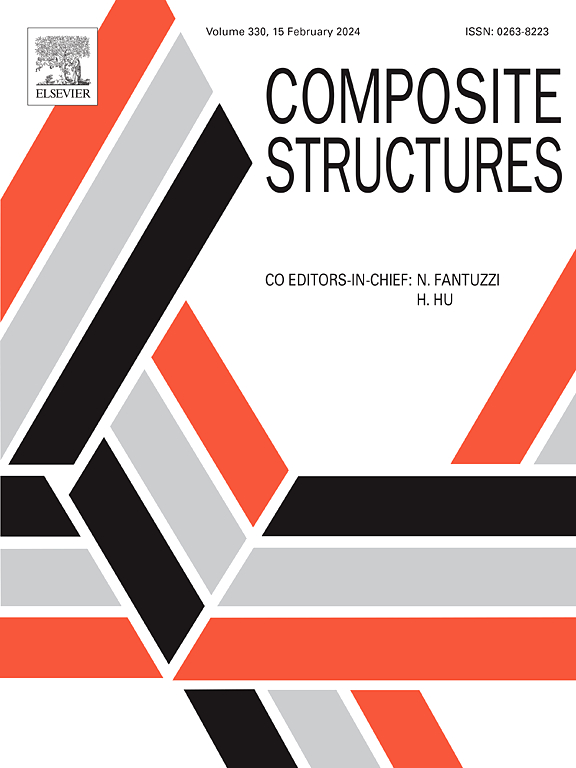冲击能和二氧化硅浓度对剪切增稠液处理织物的动态冲击和准静态抗穿刺性能的作用
IF 7.1
2区 材料科学
Q1 MATERIALS SCIENCE, COMPOSITES
引用次数: 0
摘要
本研究的主要目的是揭示剪切增稠流体对浸渍对位芳纶织物的低速冲击行为和准静态抗穿刺条件的影响。这是通过逐步提高二氧化硅的比例来实现的。流变学实验表明,60% 是二氧化硅含量的一个关键临界值,超过这个临界值,流体的流变性能就会明显改善。与纯织物相比,浸渍靶材的动态抗冲击性和准静态抗穿刺性都有大幅提高。使用相同冲击能量进行的测试结果表明,浸渍靶材的抗冲击性能(从 30.5% 到 119.2% 不等)和能量吸收性能(从 22.9% 到 61.3% 不等)均大大优于未处理的靶材。在准静态测试中,浸渍靶材的抗穿刺性能明显高于未处理的织物,从 42.3% 到 90.46%。浸渍靶材性能的提高归因于纤维间摩擦的存在、流体的增稠机制以及颗粒的硬度。与纯织物相比,在动态冲击试验中获得的性能提升大于在准静态试验中观察到的性能提升。性能的变化与威胁与目标的接触面积有关。由于刀尖施加了强大的力,与撞击器相比,刀尖与目标的接触面积较小。这导致准静态试验中颗粒硬度和增厚机制的作用小于冲击试验。此外,为了揭示冲击能量的影响,还在 20J、40J 和 60J 三种不同的冲击能量水平下进行了试验。随着冲击能量的增加,纯纺织品和浸渍纺织品的抗冲击性都有所提高。不过,与浸渍织物相比,纯织物的抗冲击性增强得更多。本文章由计算机程序翻译,如有差异,请以英文原文为准。
The role of impact energy and silica concentration on dynamic impact and quasi-static puncture resistance of fabrics treated with shear-thickening fluids
The primary objective of this study is to reveal the role of shear-thickening fluids on the low-speed impact behavior and quasi-static puncture resistance conditions of impregnated p-aramid fabric. This was achieved by progressively increasing the silica ratio methodically. Rheological experiments indicated that 60% represents a crucial threshold for silica content, over which the rheological performance of fluids markedly improves. The impregnated targets exhibited a substantial increase in both dynamic impact and quasi-static puncture resistance in comparison to the neat fabric. Results from tests using the same amount of impact energy showed that impregnated targets had much better impact resistance (ranging from 30.5% to 119.2%) and better energy absorption (ranging from 22.9% to 61.3%) than the untreated targets. In quasi-static tests, impregnated targets exhibited significantly higher puncture resistance, ranging from 42.3% to 90.46%, compared to the neat fabric. The enhanced performance of impregnated targets was ascribed to the presence of interfiber friction, the thickening mechanism of the fluid, and the hardness of the particles. Compared to the neat fabric, the performance enhancement achieved in dynamic impact tests is greater than that observed in quasistatic tests. The variation in performance was associated with the contact area of the threat with the target. Due to the intense force exerted by the knife tip, its contact area with the target is smaller in comparison to that of the impactor. This caused the particle hardness and thickening mechanism to play a lesser role in quasi-static tests compared to impact tests. In addition, to reveal the effect of impact energy, tests were carried out at three different impact energy levels: 20J, 40J, and 60J. The impact resistance of both neat and impregnated textiles improved as the impact energy went up. Nevertheless, the neat fabric exhibited a greater augmentation in resistance in contrast to the impregnated one.
求助全文
通过发布文献求助,成功后即可免费获取论文全文。
去求助
来源期刊

Composite Structures
工程技术-材料科学:复合
CiteScore
12.00
自引率
12.70%
发文量
1246
审稿时长
78 days
期刊介绍:
The past few decades have seen outstanding advances in the use of composite materials in structural applications. There can be little doubt that, within engineering circles, composites have revolutionised traditional design concepts and made possible an unparalleled range of new and exciting possibilities as viable materials for construction. Composite Structures, an International Journal, disseminates knowledge between users, manufacturers, designers and researchers involved in structures or structural components manufactured using composite materials.
The journal publishes papers which contribute to knowledge in the use of composite materials in engineering structures. Papers deal with design, research and development studies, experimental investigations, theoretical analysis and fabrication techniques relevant to the application of composites in load-bearing components for assemblies, ranging from individual components such as plates and shells to complete composite structures.
 求助内容:
求助内容: 应助结果提醒方式:
应助结果提醒方式:


